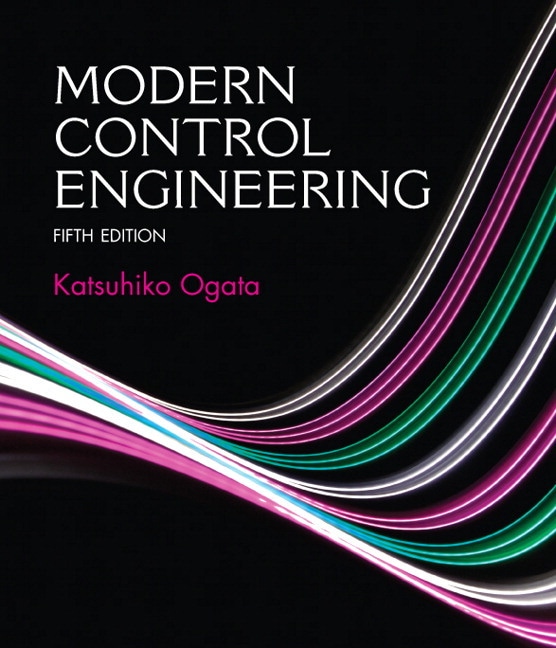
Modern Control Engineering, 5th edition
- Katsuhiko Ogata

- Find it fast
Quickly navigate your eTextbook with search
- Stay organized
Access all your eTextbooks in one place
- Easily continue access
Keep learning with auto-renew
For senior or graduate-level students taking a first course in Control Theory (in departments of Mechanical, Electrical, Aerospace, and Chemical Engineering).
A comprehensive, senior-level textbook for control engineering.
Ogata’s Modern Control Engineering, 5/e, offers the comprehensive coverage of continuous-time control systems that all senior students must have, including frequency response approach, root-locus approach, and state-space approach to analysis and design of control systems. The text provides a gradual development of control theory, shows how to solve all computational problems with MATLAB, and avoids highly mathematical arguments. A wealth of examples and worked problems are featured throughout the text.
The new edition includes improved coverage of Root-Locus Analysis (Chapter 6) and Frequency-Response Analysis (Chapter 8). The author has also updated and revised many of the worked examples and end-of-chapter problems.
Published by Pearson (July 14th 2021) - Copyright © 2022
ISBN-13: 9780137551064
Subject: Electrical Engineering
Category: Controls
Contents
- Preface
- Chapter 1 Introduction to Control Systems
- 1–1 Introduction
- 1–2 Examples of Control Systems
- 1–3 Closed-Loop Control versus Open-Loop Control
- 1–4 Outline of the Book
- Chapter 2 Mathematical Modeling of Control Systems
- 2–1 Introduction
- 2–2 Transfer Function and impulse Response Function
- 2–3 Atomatic Control Systems
- 2–4 Modeling in state space
- 2–5 State-Space Representation of Scalar Differential Equation System
- 2–6 Transformation of Mathematical models with MATLAB
- 2–7 Linearization of Nonlinear Mathematical Models
- Example Problems and Solutions Problems
- Chapter 3 Mathematical Modeling of Mechanical Systems and Electrical Systems
- 3–1 Introduction
- 3–2 Mathematical Modeling of Mechanical Systems
- 3–3 Mathematical Modeling of Electrical Systems
- Example Problems and Solutions Problems
- Chapter 4 Mathematical Modeling of Fluid Systems and Thermal Systems
- 4–1 Introduction
- 4–2 Liquid-Level Systems
- 4–3 Pneumatic Systems
- 4–4 Hydraulic Systems
- 4–5 Thermal Systems
- Example Problems and Solutions Problems
- Chapter 5 Transient and Steady-State Response Analyses
- 5–1 Introduction
- 5–2 First-Order Systems
- 5–3 Second-Order Systems
- 5–4 Higher Order Systems
- 5–5 Transient-Response Analysis with MATLAB
- 5–6 Routh's Stability Criterion
- 5–7 Effects of Integral and Derivative Control Actions on System Performance
- 5–8 Steady-State Errors in Unity-Feedback Control Systems
- Example Problems and Solutions Problems
- Chapter 6 Control Systems Analysis and design by the Root-Locus Method
- 6–1 Introduction
- 6–2 Root-Locus Plots
- 6–3 plotting Root Loci with MATLAB
- 6–4 Root-Locus Plots of Positive Feedback Systems
- 6–5 Root-Locus Approach to control Systems Design
- 6–6 Lead Compensation
- 6–7 Lag Compensation
- 6–8 Lag-Lead Compensation
- Example Problems and Solutions Problems
- Chapter 7 Control Systems Analysis and Design by the Frequency Response Method
- 7–1 Introduction
- 7–2 Bode Digrams
- 7–3 Polar Plots
- 7–4 Log-Magnitude-versus-Phase plots
- 7–5 Nyquist Stability Criterion
- 7–6 Stability Analysis
- 7–7 Relative Stability Analysis
- 7–8 Closed-Loop Frequency Response of Unity-feedback Systems
- 7–9 Experimental Determination of Transfer functions
- 7–10 Control Systems design by Frequency Response Approach
- 7–11 Lead Compensation
- 7–12 Lag Compensation
- 7–13 Lag-Lead Compensation
- Example Problems and Solutions Problems
- Chapter 8 PID Controllers and Modified PID Controllers
- 8–1 Introduction
- 8–2 Ziegler- Nichols Rules for tuning PID controllers
- 8–3 Design of PID Controllers with Frequency Response Approach
- 8–4 Design of PID Controllers with Computational Optimization Approach
- 8–5 Modification of PID Control Schemes
- 8–6 Two-Degrees-of-freedom PID Control Schemes
- 8–7 Zero Placement Approach to Improve Response
- Example Problems and Solutions Problems
- Chapter 9 Control Systems Analysis in State Space
- 9–1 Introduction
- 9–2 State-space Representations of Transfer-Function Systems
- 9–3 Transformation of System Models with MATLAB
- 9–4 Solving the Time-Invariant State Equation
- 9–5 Some Useful Results in vector-Matrix Analysis
- 9–6 Controllability
- 9–7 Observability
- Example Problems and Solutions Problems
- Chapter 10 Control Systems Design of in State Space
- 10–1 Introduction
- 10–2 Pole Placement
- 10–3 Solving Pole-Placement Problems with MATLAB
- 10–4 Design of Servo Systems
- 10–5 State Observers
- 10–6 Design of Regulator Systems with Observers
- 10–7 Design of Control Systems with Observers
- 10–8 Quadratic Optimal Regulator Systems
- 10–9 Robust Control Solutions
- Example Problems and Solutions Problems